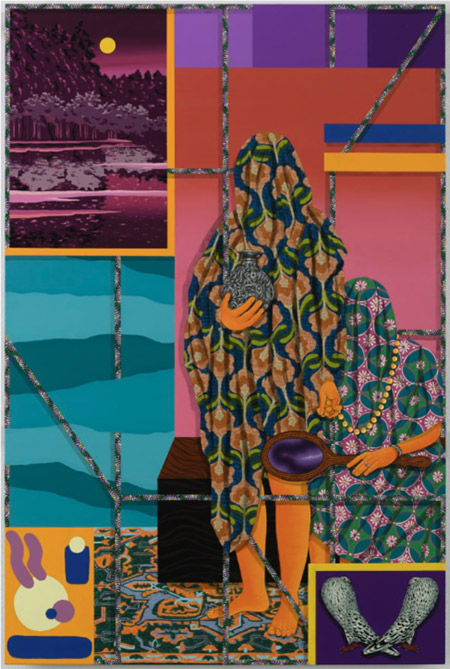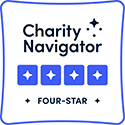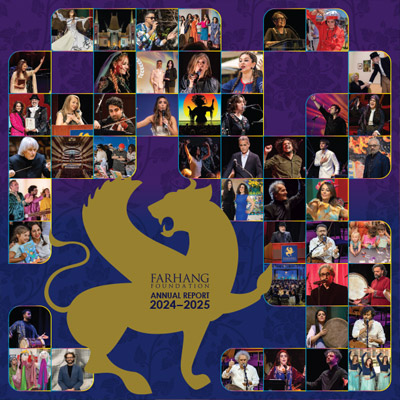Amir H. Fallah: The Fallacy Of Borders
FOR IMMEDIATE RELEASE
Friday January 27, 2023

The Artist's Los Angeles Museum Debut Explores Creative Inspiration and Collaboration Across Real and Imagined Borders
January 29 - May 14, 2023
LOS ANGELES – Farhang Foundation is proud to join the Fowler Museum at UCLA in presenting Amir H. Fallah: The Fallacy of Borders, the artist’s first museum exhibition in Los Angeles. A celebration of Fallah’s vibrant maximalist style, more than 25 works of painting, sculpture, and stained glass contend with urgent themes of cultural inheritance and identity formation.
Born in 1979 in Tehran at the height of the Islamic Revolution, Fallah and his family moved several times before he arrived in the U.S. at the age of seven. Throughout his career, he has mined intimate aspects of his immigrant experience to forge an alternative portraiture, one that resists reductive characterization. This exhibition highlights the visual strategies and influences that underpin Fallah’s approach, which blends elements of his Iranian American heritage with those of other global traditions and their adaptations in Los Angeles’s diasporic communities.
The installation opens with an archive of Beautiful/Decay, the art and design magazine that Fallah founded, edited, and published from 1996 to 2013. The first-time exhibition of this publication and associated ephemera highlights his journey from graffiti artist to graphic designer to publisher— pursuits that sparked an autobiographical process of collaging found images. This longstanding practice of graphic remix has provided an expansive visual language to interrogate and transcend the boundaries and borders that separate people, cultures, and art practices.
Organized around eight thematic nodes, the Fowler presentation features collaborations, commissions, and long-standing series in a range of media. Commentary by Fallah, exhibition curator Amy Landau, award-winning graphic designer Willem Henri Lucas, and David Judson of Judson Studios can be heard via QR codes.
“This exhibition spotlights Fallah’s broad visual literacy, experimental drive, and creative receptivity—all anchored in his migrant experience,” said exhibition curator Amy Landau, director of interpretation and education at the Fowler. “He narrates from trauma and celebration, as well as his roles as a husband, father, and confidant, which lends a deeply humane aspect to his social critique.”
"Here at Farhang Foundation, we have been great admirers of Amir H. Fallah's work for many years, and we are extremely proud to be able to join forces with the Fowler Museum at UCLA in presenting this exceptional show as the Cultural Partner of the exhibition," said Alireza Ardekani, executive director at Farhang Foundation.
About the Exhibition
Beautiful/Decay
In this opening section, a gathering of back issues, t-shirts, media kits, and event invitations conjures the highly specific and generative world of Beautiful/Decay. Fallah produced his first photocopied zines in 1996 at the age of 16. By 2001, the project had transformed into a full-color publication featuring wide-ranging coverage of groundbreaking work across artistic fields. The magazine evolved into a book, published in nine volumes between 2009 and 2013. Each hand- numbered edition was birthed in partnership with a diverse array of creatives, and was accompanied by screen-prints, sticker packs, and other collectibles.
New Worlds | Old Worlds
Inspired by seventeenth-century Flemish garland paintings, Fallah’s tondo paintings combine flora from across the globe with images from vintage valentines, matchboxes, and anatomy illustrations, among other sources. For Fallah, the botanical imagery serves as a metaphor for immigrants seeking to thrive in their adoptive countries. The series can also be read as an allegory of Los Angeles, where indigenous and non-native flora coexist, resulting in new ecosystems replete with histories of colonization and conquest.
In an alternative meditation on migration and dominance, the Fowler-commissioned painting Invisible Line (2022) illustrates how museum collections can serve as documents of emigration and loss, while enhancing visitors’ visual literacy. A central figure—drawn from a Persian miniature painting—floats over a seventeenth-century Dutch map, the canvas perimeter lined with renderings of works in the Fowler collection: a Peruvian woven textile, a Japanese votive offering, and a pre-Columbian ceramic figure sculpted by the Colima people of Mexico.

Objects | Memories
Fallah tells personal stories associated with objects such as heirloom jewelry, collected textiles, or dolls, calling attention to the power of things to create bonds and evoke memories. Two paintings in this section center on veiled figures, surrounded by various objects that take the place of physiognomic characteristics, and record aspects of the sitters, the roads they have travelled, and the people for whom they care.
Portraiture
Fallah collaborates closely with the individuals he portrays in constructing their “likenesses.” He visits and interviews them at home, looking for patterns of significance. Eschewing such markers of identity as gender, skin color, and ethnicity, he obscures the heads and bodies of his sitters with patterned fabrics. He then surrounds them with objects and symbols that span cultures and generations, challenging simplistic assumptions about who a person is based on their appearance.
Stained Glass
For this series of four windows, Fallah collaborated with Los Angeles-based Judson Studios, the oldest family-run stained-glass workshop in America, whose team meticulously translated the artist’s elaborate compositions into fused and leaded glass panels. Throughout his career, Fallah has experimented with oil and acrylic paints, seeking to achieve a high degree of luminosity to elicit emotional responses. The collaboration with Judson enabled him and the studio team to explore and expand the expressive potential of color and light.
Autobiography
Fallah draws inspiration from a variety of visual expressions unique to his adoptive city of Los Angeles, home to millions with migration stories. Reflections on cultural inheritance, diaspora, and homeland thread through his work. While addressing such ills as hatred, greed, and corruption, his paintings also offer hopeful and sentimental messages, aggregating the life lessons Fallah wishes to share with his son. For example, No Gods, No Masters (2020) calls out racist stereotypes through the depiction of Middle Eastern characters, while also referencing his son’s storybooks, quotations from Islamic manuscript paintings, and popular American illustrations.
Allegory
The canvases in this section are divided into grid-like spaces, each a treasury of references to cultural heritage, emblems of devotion, family heirlooms, and references to modern art that coalesce into cautionary tales, social commentary, and stories of love. They Will Say a Collection of Untruths (2022) critiques the American promise of co-existence of religions and “races.” The psychedelic profile in the center riffs on a Milton Glaser graphic from a 1960s teen magazine feature on “combination skin.”
Sculpture
Fallah’s sculptures—hand-painted on flat sheets of cut aluminum—continue to challenge the expectations of portraiture, excluding references to gender, ethnicity, or class. The vibrant colors and dense patterns that appear elsewhere in Fallah’s work cover the entirety of these figures. According to the artist, these patterns function as skin, offering a protective layer to other life-giving organs, which are represented by the objects and symbols painted on the cut-outs or rendered as part of the figures’ outlines.
A Dual Presentation in Los Angeles
Concurrent with Amir H. Fallah: The Fallacy of Borders organized by the Fowler Museum at UCLA (January 29–May 14, 2023), Shulamit Nazarian, Los Angeles will present Fallah’s work in the solo exhibition War on Wars, on view February 15–March 25, 2023. The artist has also produced a new neon sign, titled CHANT, soon to be installed on the front of Shulamit Nazarian gallery. The piece is intended to generate attention and awareness, as well as funds from its sale, for the “Woman, Life, Freedom” movement in Iran.
The presentation of Fallah’s art across Los Angeles reflects his ongoing dialogue with the city— one with a broadly diasporic character, including, among others, the largest Iranian population outside Iran. Shulamit Nazarian and the Fowler Museum are both committed to representing artists whose perspectives are often proximal, but insufficiently highlighted. Fallah’s work engages stereotypes of “distant” cultures and empowers viewers to read his work through visual signs and systems.
A Dual Presentation in Los Angeles
About the Artist
Amir H. Fallah (b. 1979, Tehran, Iran; lives and works in Los Angeles, CA) received his BFA in Fine Art & Painting at the Maryland Institute College of Art and his MFA in painting at the University of California, Los Angeles. His work has been shown extensively in solo and group exhibitions across the United States and abroad. His solo presentations have appeared at the Museum of Contemporary Art in Tucson, AZ; South Dakota Art Museum, Brookings, SD; Schneider Museum of Art, Ashland, OR; San Diego ICA, CA; and the Nerman Museum of Contemporary Art, Overland, KS.
Credits
Amir H. Fallah: The Fallacy of Borders is organized by the Fowler Museum at UCLA and curated by Amy Landau, director of education and interpretation. Major support is provided by the Fowler Contemporary Council Fund, Clough/Hillenburg Fund, and Fay Bettye Green Fund. Additional generous support is provided by the Younes & Soraya Nazarian Family Foundation, Peyton Family Foundation, George R. and Nancy Ellis Endowment Fund, Farhang Foundation, Azita and George Fatheree, Tad Freese and Brook Hartzell, Pamela and David Hornik, Cheryl and Bruce Kiddoo, Shulamit Nazarian Gallery, Orna Delrahim, Aryan Papoli and Abas Goodarzi, First Financial Capital Inc and Katy Saei, Connie McCreight, Jay Geller and Lowell Gallagher, and Avant Arte.
About the Fowler
The Fowler Museum at UCLA explores global arts and cultures with an emphasis on Africa, Asia, the Pacific, and the Indigenous Americas—past and present. The Fowler enhances understanding of world cultures through dynamic exhibitions, publications, and public programs, informed by interdisciplinary approaches and the perspectives of the cultures represented. The work of international contemporary artists is presented within complex frameworks of politics, culture, and social action.
Museum Information
308 Charles E Young Dr N | Los Angeles, CA 90095 | fowler.ucla.edu/visit Parking in UCLA Lot 4: 198 Westwood Plaza at Sunset Blvd, $3/hr Rideshare drop-off: 305 Royce Drive
Hours: Wednesday–Sunday, 12–5 pm Admission to the Fowler is free
CAPTIONS
Top – left to right:
Amir H. Fallah (b. 1979, Tehran, Iran), Protector 1, 2022; acrylic on canvas; Courtesy of the artist and Ginsberg Family Collection
They Will Say a Collection of Untruths, 2022; acrylic on canvas; Courtesy of the artist and Shulamit Nazarian, Los Angeles
Bottom
Urn, 2022; acrylic on canvas; Courtesy of the artist and Shulamit Nazarian, Los Angeles
ABOUT FARHANG FOUNDATION
 |
Farhang Foundation is a member-supported nonreligious, nonpolitical and nonprofit foundation established in 2008 to celebrate and promote Iranian art and culture for the benefit of the community-at-large. The foundation supports a broad range of academic and cultural activities by funding university programs, diverse cultural programs such as the celebrations of Nowruz, and Shab-e Yalda as well as musical performances, film screenings and festivals. |
For media inquiries contact:
Tannaz Guivi | press@farhang.org / 310-666-1546







